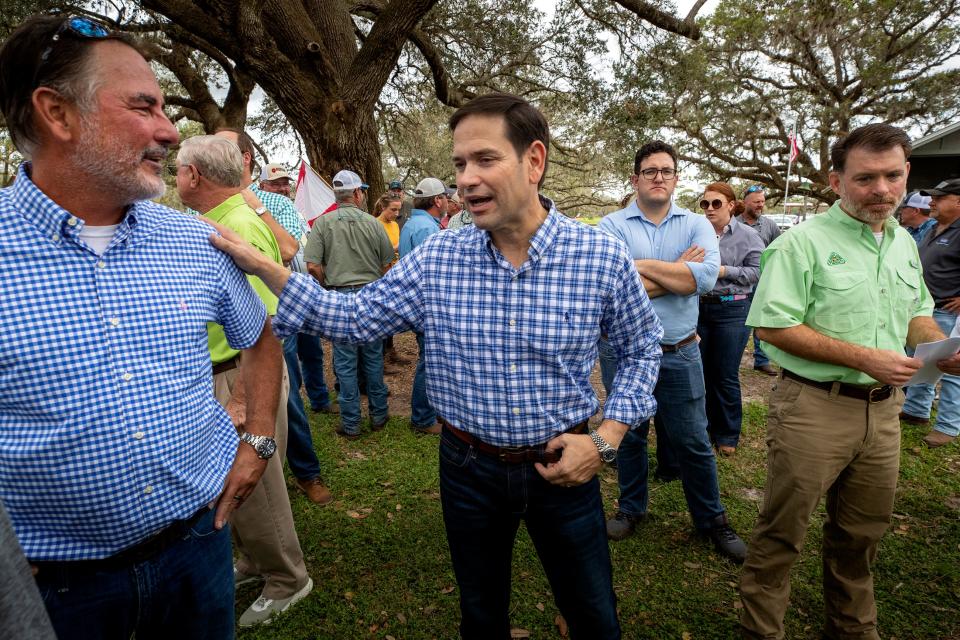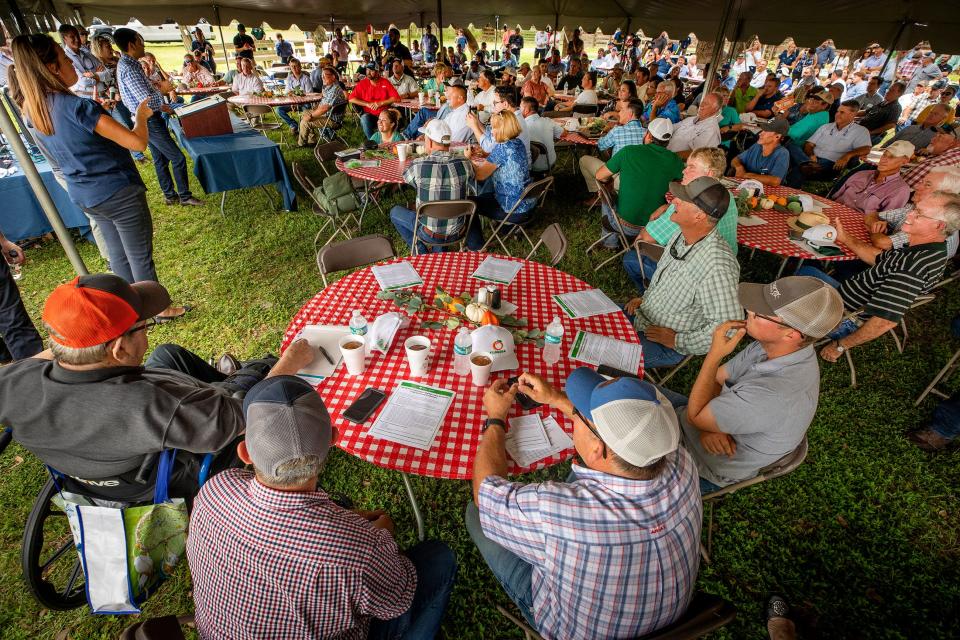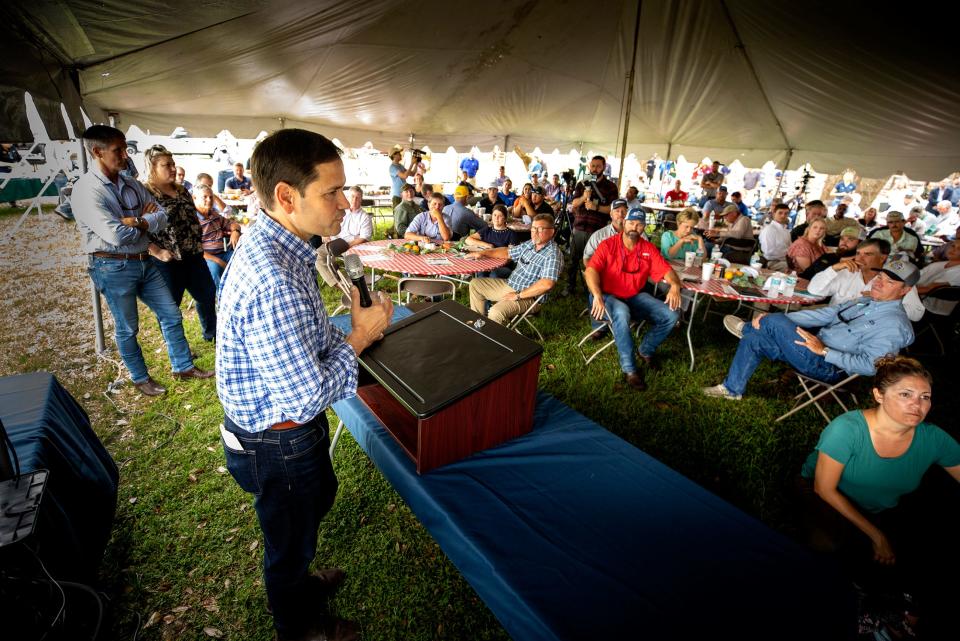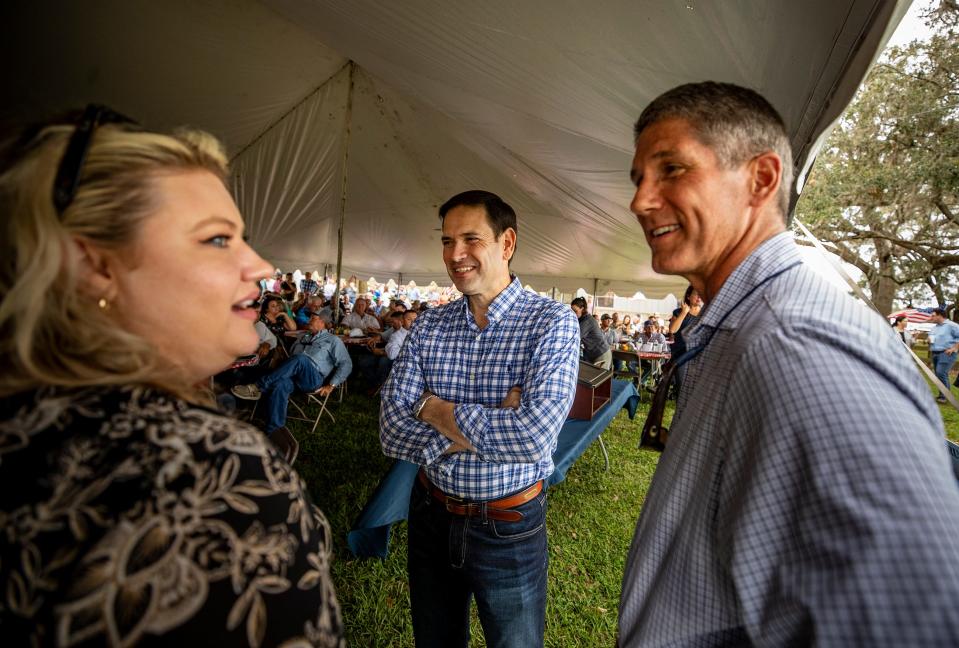Rebuild or give up? Florida citrus growers explore options after losses to Hurricane Ian
There was one number that growers and politicians alike could not sidestep at Wednesday’s initial USDA citrus forecast: only 28 million boxes of Florida oranges were predicted for the coming harvest.
Assembled for the forecast at Putnam Groves, a citrus farm and cattle ranch in Zolfo Springs operated by former politician Adam Putnam, guests included U.S. Sen. Marco Rubio and U.S. Reps. Scott Franklin and Kat Cammack, who tried to console the nearly 300 growers under a catering tent following Hurricane Ian.
The gathering on Wednesday was part of the Florida Citrus Mutual's Annual Citrus Crop Luncheon. The event was presided over by Mutual’s executive vice president and CEO Matt Joyner. He called Rubio a “stalwart” and “champion” of the citrus industry before handing him the microphone.
Ian's impact: Citrus crop losses from Ian expected to top 80 percent in some areas
‘Just heartbreaking’: Southwest Florida small family farmers struggle after Hurricane Ian
Also: USDA releases final citrus forecast for 2021-2022 growing season
“The challenges we’re facing in Florida agriculture in general and citrus in particular have been nothing short of Biblical in some ways,” Rubio said. “It almost feels like every time we take a step forward, we get hit with two steps back."
Florida citrus growers already had record low numbers in 2021
Last year, Florida growers picked 42 million boxes, according to the U.S. Department of Agriculture – an amount that was already the lowest on record since World War II.
Decades ago, during the heyday of citrus growing in Florida, 250 million boxes were harvested mostly for orange juice.
Citrus grower Kenny Sanders, 70, of Wauchula who has 180 acres in Hardee County said he has been propping up trees that blew over since the storm. He estimated a loss of 30% of his early season Hamlin oranges and has yet to determine the impact on his later-season Valencia crop.
Sanders said he is committed to not giving up on growing citrus.
“What’s next is working hard,” he said.

Grower Ashley Schafer, 39, of Arcadia had already planned to convert a large block of land currently dedicated to citrus into row crops and sod.
“This was our last hurrah,” she said of the coming citrus season.
Anatomy of an orange: Lawmakers from Florida seek to change FDA rules for sugar levels in juice oranges
Denied: Polk planning board rejects zoning change for HCA hospital in South Lakeland. What's next?
Water woes: Kissimmee Chain of Lakes, headwaters of Everglades, at near record levels — and rising
Instead of going out strong, Schafer's operation faces a loss of 75% of her early citrus fruit at 2X4 Ranch in DeSoto County, where she said she witnessed the eye of the hurricane pass overhead.
“It seems like every day I go down there, I’ve got more fruit on the ground,” Schafer said, still unsure of the total damage to the crop. It took 72 hours straight to pump out all the flooded land along Joshua Creek within the Peace River Basin, she said.
For the past two decades, the industry has been in free fall due to citrus tree diseases, hurricanes and land development pressure.
“The strength and resilience of Floridians are inspiring, but we have a long recovery ahead,” Rubio said.

Environmental and economic issues plague Florida citrus industry
The citrus industry was hit hard and suffering from some localized losses of between 80% to 100% due to Hurricane Ian, according to Citrus Mutual’s president Glenn Beck, a fourth-generation grower at Beck Brothers Citrus. The Becks operate on 6,500 acres in six counties including Polk.
“There are portions of DeSoto and Highland County where they are at 100% losses,” Beck said.
Those growers who decide to keep going will face challenges beyond disease and natural disasters. Inflation has meant higher costs for fertilizer and diesel fuel for farm equipment, Beck said.
Further, Beck said, many growers decided to “roll the dice” and did not take out crop insurance. And, Hurricane Ian may be too costly of a hurdle to clear financially considering the long-term investment needed to start over.
“It will ultimately put more growers out of the industry,” he said.
The U.S. all-orange forecast for the upcoming growing season was 3.19 million tons, down 8% from the 2021-2022 final utilization, the USDA said. Florida dragged down the nation’s overall output with 1.26 million tons predicted, a 32% drop in production in the state.
Florida’s early, midseason and navel varieties were forecast at 11 million boxes (495,000 tons), down 40% from last season's final utilization. The Florida Valencia orange forecast was 17 million boxes (765,000 tons). That is down 25% from last season's final utilization.

The USDA crop report did not specifically say if its estimates reflected damage to Florida’s growers due to Hurricane Ian.
“Today’s citrus forecast, surveyed prior to Hurricane Ian ravaging the Florida Citrus Industry’s 375,000 acres of commercial citrus, will be an invaluable baseline for growers, processors, packers and government in predicting additional crop loss," Florida agriculture commissioner Nikki Fried said in a statement Wednesday.
"As we move forward in the wake of this disaster, rest assured that I remain steadfast in my support of our Florida citrus growers, and my department remains committed to innovation in the face of the ongoing challenges of weather events like Ian, citrus greening and unfair trade practices,” she added.
Getting government assistance
Following the North American Free Trade Agreement, specialty crop growers have faced stiff competition from imports from countries across the globe.
Imports have not impacted consumers as much as U.S. citrus growers. While Florida’s crop has declined in recent times, imports from Brazil and Mexico have stabilized the availability of oranges for both juicing and eating and keeping a check on prices for the commodity.
On the agenda at the Putnam Ranch was post-Hurricane Ian recovery information and another session explained to growers the assistance available to them.
State and federal government agencies such as FEMA and the SBA had staffed tables for growers interested in restoring their agricultural businesses. An initial damage assessment by federal agencies put the overall Hurricane Ian damage estimate at $33 billion.
Rubio has requested Hurricane Ian supplemental appropriations for the Department of Agriculture, which includes $2 billion in funding for a Wildfires and Hurricane Indemnity Program to cover agricultural costs due to crop losses and other USDA programs.
“We’ve had a lot of things that have impacted the citrus industry,” said Dean Saunders, executive director and senior advisor at SVN Saunders, Ralston, Dantzler in Lakeland.

There was disease, hurricanes and freezes. Citrus canker disease was the first of the pests followed by greening. There were hurricanes Charley, Irma and now Ian, which all passed over Florida’s citrus growing region mostly south of Interstate 4. Severe freezes had also wiped out most growers north of I-4.
Florida’s current citrus growing areas are within the largest agricultural district east of the Mississippi River. During Florida’s booming years of citrus production, there was about 900,000 acres of groves producing citrus but today that area is 370,000, Saunders said.
While Polk County once led the state in both production of citrus fruits and total acreage devoted to the crop, DeSoto County has more grove land at 66,000 acres but Polk still outproduces any other county in Florida.
He noted that infrastructure to pack and process fruit has also been shuttered in recent decades making it virtually impossible for the industry to return to its historic peak harvests.
“The infrastructure has got to have fruit,” he said. “It’s a sad thing.”
Now with Hurricane Ian damages “Yes, there will be people who throw up their hands and say: No mas [no more]!” Saunders said. “I hate to see it but that is what is going to happen.”
Paul Nutcher can be reached at pnutcher@gannett.com.
This article originally appeared on The Ledger: Florida orange groves in danger after Hurricane Ian hits
